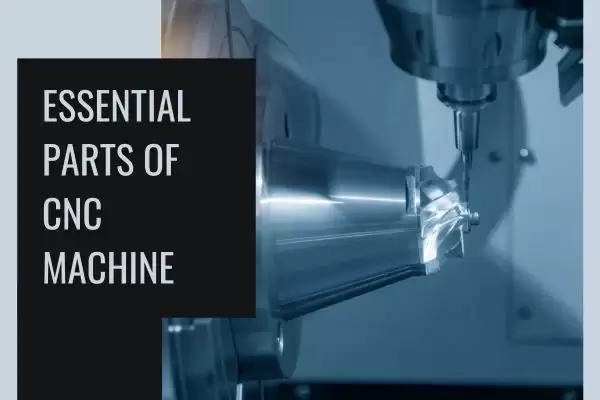
Nov 17,2023
Welcome to the heart of modern manufacturing, where precision meets innovation - the realm of CNC machines. CNC machines play a pivotal role in the intricate dance of metal, wood, and various materials, transforming digital designs into tangible creations. In this exploration, we'll dissect the 12 essential parts of a CNC machine, unraveling the mystery behind these mechanical marvels.
At the core of every CNC machine lies a robust structure that is the foundation for precision. Typically crafted from durable materials such as cast iron or steel, this structure provides stability and rigidity, ensuring the machine's accuracy during operation. The design of this structure plays a crucial role in determining the overall performance of the CNC machine, influencing factors like vibration, thermal stability, and machining precision.
The motors drive the graceful movements of a CNC machine. These mechanical powerhouses come in various types, including stepper and servo motors, each catering to specific applications. Stepper motors excel in providing precise control over movement, while servo motors offer speed and efficiency. Understanding the nuances of these motors is key to optimizing CNC machine performance and achieving desired results in the manufacturing process.
Imagine a CNC machine as a sophisticated robot moving multiple axes to carve intricate designs. These axes - X, Y, Z, and sometimes A, B, and C - dictate the machine's range of motion. The coordination of these axes enables the creation of complex shapes and contours. Delving into the world of multi-axis machining opens up new possibilities for creativity and efficiency in manufacturing.
The control panel is the nerve center of a CNC machine, where human input meets machine execution. Operators interact with the control panel to program the machine, set parameters, and monitor the machining process. Understanding the functions and controls on this panel is essential for anyone operating a CNC machine. Here, the magic of translating digital designs into tangible products begins.
If the CNC machine is the artist, the spindle is its brush. The spindle is responsible for rotating the cutting tools determining the speed and precision of the machining process. Different types of spindles cater to specific applications, from high-speed milling to precision engraving. Mastering the nuances of spindle operation is key to achieving the desired finish and accuracy in CNC machining.
In the world of CNC machining, time is money. Automatic tool changers come to the rescue by seamlessly swapping cutting tools during machining. This reduces downtime and opens the door to more complex and intricate designs. Exploring the possibilities offered by different tool changers allows operators to optimize efficiency and take on more challenging projects.
Beneath the intricate dance of moving parts, the machine bed and table provide a stable platform for the manufacturing symphony. The bed's structure and material influence the machine's overall rigidity, directly impacting precision. CNC machines have various bed types, such as fixed beds and rotary tables, each tailored to specific applications. Choosing the right bed is akin to selecting the perfect canvas for an artist.
Precision machining generates heat, and excessive heat can compromise both tools and workpieces. Enter the coolant system, a crucial component in the CNC machine's arsenal. Coolant systems dissipate heat and remove chips and debris, ensuring a clean and efficient machining process. Exploring the different types of coolant systems and their applications is vital for maintaining tool longevity and achieving optimal results.
Behind the scenes, lubrication systems quietly contribute to the smooth operation of a CNC machine. Proper lubrication reduces friction, preventing wear and tear on crucial components. Understanding the types of lubrication systems and implementing regular maintenance routines ensures that the CNC machine operates like a well-oiled machine, both figuratively and literally.
In the digital age, the software is the invisible hand guiding CNC machines through intricate movements. CNC machine software translates design files into machine-readable code, dictating the toolpaths and operations. Familiarizing oneself with popular CNC programming languages and software tools empowers operators to unleash the full potential of their machines, turning imagination into reality.
Safety takes center stage in the world of CNC machining. Modern CNC machines are equipped with various safety features to protect operators and the workplace. From emergency stop buttons to protective enclosures, understanding and adhering to safety protocols is non-negotiable. Creating a secure working environment ensures that the magic of CNC machining happens without unnecessary risks.
CNC machines require regular maintenance to operate at peak performance like any complex machinery. A well-thought-out maintenance routine is the key to longevity, from checking and replacing cutting tools to inspecting and lubricating moving parts. Additionally, having a troubleshooting toolkit and the know-how to address common issues minimizes downtime, keeping the production wheels turning.
As we conclude our journey into the intricate world of CNC machines, it's evident that these mechanical marvels are more than just tools - they are gateways to innovation and precision. Each of the 12 essential parts plays a crucial role in the symphony of creation, where digital designs come to life with unparalleled accuracy. Whether you're an operator, enthusiast, or industry professional, understanding these components unlocks the full potential of CNC machining, making the impossible possible in manufacturing. So, embrace the intricacies, master the nuances, and let the CNC machine be your canvas for creativity and precision.